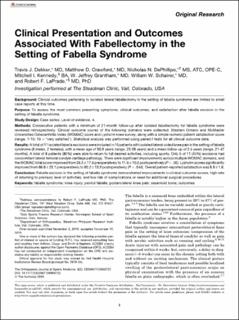| dc.contributor.author | Dekker, Travis J. | |
| dc.contributor.author | Crawford, Matthew D. | |
| dc.contributor.author | DePhillipo, Nicholas | |
| dc.contributor.author | Kennedy, Mitchell I. | |
| dc.contributor.author | Grantham, W. Jeffrey | |
| dc.contributor.author | Schairer, William W. | |
| dc.contributor.author | LaPrade, Robert F. | |
| dc.date.accessioned | 2021-06-04T09:08:47Z | |
| dc.date.available | 2021-06-04T09:08:47Z | |
| dc.date.created | 2020-11-11T12:23:01Z | |
| dc.date.issued | 2020 | |
| dc.identifier.citation | Orthopaedic Journal of Sports Medicine. 2020, 8(2), Artikkel 2325967120903722. | en_US |
| dc.identifier.issn | 2325-9671 | |
| dc.identifier.uri | https://hdl.handle.net/11250/2757653 | |
| dc.description | This open-access article is published and distributed under the Creative Commons Attribution - NonCommercial - No Derivatives License (https://creativecommons.org/licenses/by-nc-nd/4.0/), which permits the noncommercial use, distribution, and reproduction of the article in any medium, provided the original author and source are credited. You may not alter, transform, or build upon this article without the permission of the Author(s). For article reuse guidelines, please visit SAGE’s website at http://www.sagepub.com/journals-permissions. | en_US |
| dc.description.abstract | Background: Clinical outcomes pertaining to isolated lateral fabellectomy in the setting of fabella syndrome are limited to small case reports at this time.
Purpose: To assess the most common presenting symptoms, clinical outcomes, and satisfaction after fabella excision in the setting of fabella syndrome.
Study Design: Case series; Level of evidence, 4.
Methods: Consecutive patients with a minimum of 21-month follow-up after isolated fabellectomy for fabella syndrome were reviewed retrospectively. Clinical outcome scores of the following domains were collected: Western Ontario and McMaster Universities Osteoarthritis Index (WOMAC) score and Lysholm knee survey, along with a simple numeric patient satisfaction score (range, 1-10; 10 = ?very satisfied?). Statistical analysis was performed using paired t tests for all clinical outcome data.
Results: A total of 11 isolated fabella excisions were included in 10 patients with isolated lateral-sided knee pain in the setting of fabella syndrome (8 males, 2 females), with a mean age of 36.9 years (range, 23-58 years) and a mean follow-up of 2.4 years (range, 21-47 months). A total of 8 patients (80%) were able to return to full desired activities, including sports. Only 5 of 11 (45%) excisions had concomitant lateral femoral condyle cartilage pathology. There were significant improvements across multiple WOMAC domains, and the WOMAC total score improved from 28.5 ± 17.6 preoperatively to 11.6 ± 10.2 postoperatively (P < .05). Lysholm scores significantly improved from 66.6 ± 23.1 preoperatively to 80.2 ± 13.9 postoperatively (P = .044). Overall patient-reported satisfaction was 8.8 ± 1.6.
Conclusion: Fabella excision in the setting of fabella syndrome demonstrated improvements in clinical outcome scores, high rate of returning to preinjury level of activities, and low risk of complications or need for additional surgical procedures. | en_US |
| dc.language.iso | eng | en_US |
| dc.subject | fabella syndrome | en_US |
| dc.subject | knee injury | en_US |
| dc.subject | outcomes | en_US |
| dc.subject | painful fabella | en_US |
| dc.subject | posterolateral knee pain | en_US |
| dc.subject | sesamoid bone | en_US |
| dc.title | Clinical presentation and outcomes associated with fabellectomy in the setting of fabella syndrome | en_US |
| dc.type | Peer reviewed | en_US |
| dc.type | Journal article | en_US |
| dc.description.version | publishedVersion | en_US |
| dc.rights.holder | © The Author(s) 2020 | en_US |
| dc.source.pagenumber | 5 | en_US |
| dc.source.volume | 8 | en_US |
| dc.source.journal | Orthopaedic Journal of Sports Medicine | en_US |
| dc.source.issue | 2 | en_US |
| dc.identifier.doi | 10.1177/2325967120903722 | |
| dc.identifier.cristin | 1846908 | |
| dc.description.localcode | Institutt for idrettsmedisinske fag / Department of Sports Medicine | en_US |
| dc.source.articlenumber | 2325967120903722 | en_US |
| cristin.ispublished | true | |
| cristin.fulltext | original | |
| cristin.qualitycode | 1 | |
